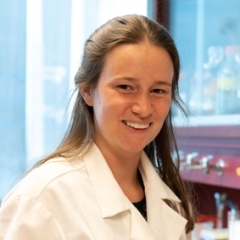Knauss legislative fellowships in Congress help build careers — and they're fun and educational. See our video and fact sheet for details.
To pursue a doctorate or not . . . that is the question
Deciding whether to pursue a PhD in a scientific field can feel the same as Hamlet’s phrase contemplating between existence and non-existence. For a young person deciding his or her life’s course, it’s a pretty big decision. A PhD is a long-term commitment filled with a lot of work and little pay. Will you enjoy it? Or will you simply endure it? Through pursuing my master’s degree and now my doctorate, I have discovered some of the key decisions made during the program that can help to keep one happy and sane during graduate school. I have used this decision-making process to choose my research topic as a first-year PhD candidate in marine science at the University of Maryland Center for Environmental Science-Institute of Marine and Environmental Technology, where my research focuses on the toxins produced by algae which can be detrimental for ecosystems and human health.
The most pivotal moment in making sure the next five to seven years are as enjoyable as possible comes during the first few months of the program, when finding a research topic. My goal throughout my program is to laugh as much as possible, and reading Jorge Cham’s Piled Higher and Deeper (PhD) comic strips about life in academia put a humorous spin on interesting life situations that are quite relatable. This comic on intellectual freedom in particular brings up an important, difficult topic of discussion for all research scientists: How do I decide what to research?
I have heard from many researchers that the hardest part of a PhD is focusing on a single topic for such a long amount of time. It is vital to my well-being that I do not fall victim to studying whatever my professor wants during my PhD research (unless that is what I want as well). Part of writing a thesis or dissertation is delving into a specific topic that contributes to the body of knowledge in the chosen field. For example, my master’s thesis focused on how the nitrogen isotope signature (N15:N14 ratio) changed when the toxin producing microalgae, Alexandrium catenella, used different nitrogen sources. This research helps scientists better identify what nutrient source the microalgae are taking up. This was an already funded project that was given to me by my advisor and I just needed to figure out the best ways to answer the questions presented in the project proposal.
I only had to focus on my master’s topic for two and a half years, compared to five to seven years for PhD research. So, to the extent that is possible, the focus of my research should be something I am interested in and has my ideas incorporated. Graduate fellowships exist so students can move beyond the funded research in their advisor’s labs and pursue their interests.
I have a checklist to find the perfect dissertation topic and maximize the likelihood the next five to seven years are beneficial, both to my education and to the field. The project must check the following boxes:
- Can I see benefits to this research?
- Does it relate to my advisor’s research?
- Does it build on skills I want to learn?
- Are there identified end-users who will benefit from the research?
- Will different chapters of the dissertation be able to emphasize different skills?
My advisor, Allen Place, has made it clear that he is there to advise. He likes to say, “I am here to make sure you do not fall down a rabbit hole.” In Alice in Wonderland, Alice falls down a rabbit hole, which is supposed to symbolize a situation or journey that is difficult, problematic, chaotic, and overall strange. I do not want such a journey to define my doctorate work, which it could without guidance from my advisor. Professors have experience knowing how to find projects that answer the above questions and have a better likelihood of interesting results.
I started in a lab that broadly covered the topics I wanted to research: looking at the toxins produced by harmful algae and different techniques to manage harmful algal blooms. Harmful algal blooms are a problem in the Chesapeake Bay and other areas of the world. They can cause oxygen-depleted waters, which lead to fish kills, and block light that seagrasses need to grow. Some can also produce toxins that may accumulate in shellfish and cause human health concerns. Figuring out how to monitor and manage them could help to reduce such negative impacts.
While learning about lab projects, I read my advisor’s previous publications and researched government-agency documents on algal blooms. I knew I wanted to have diverse dissertation chapters that varied from basic to applied research. I outlined varying ideas for a dissertation project to my advisor, and together we came up with a project that checked all of my boxes. I applied for graduate fellowships to study natural algicides that can be used to inhibit toxic algae. Now, a year into my PhD, I am excited to be pursuing this research, which makes me a happy graduate student.
See all posts to the Fellowship Experiences blog



